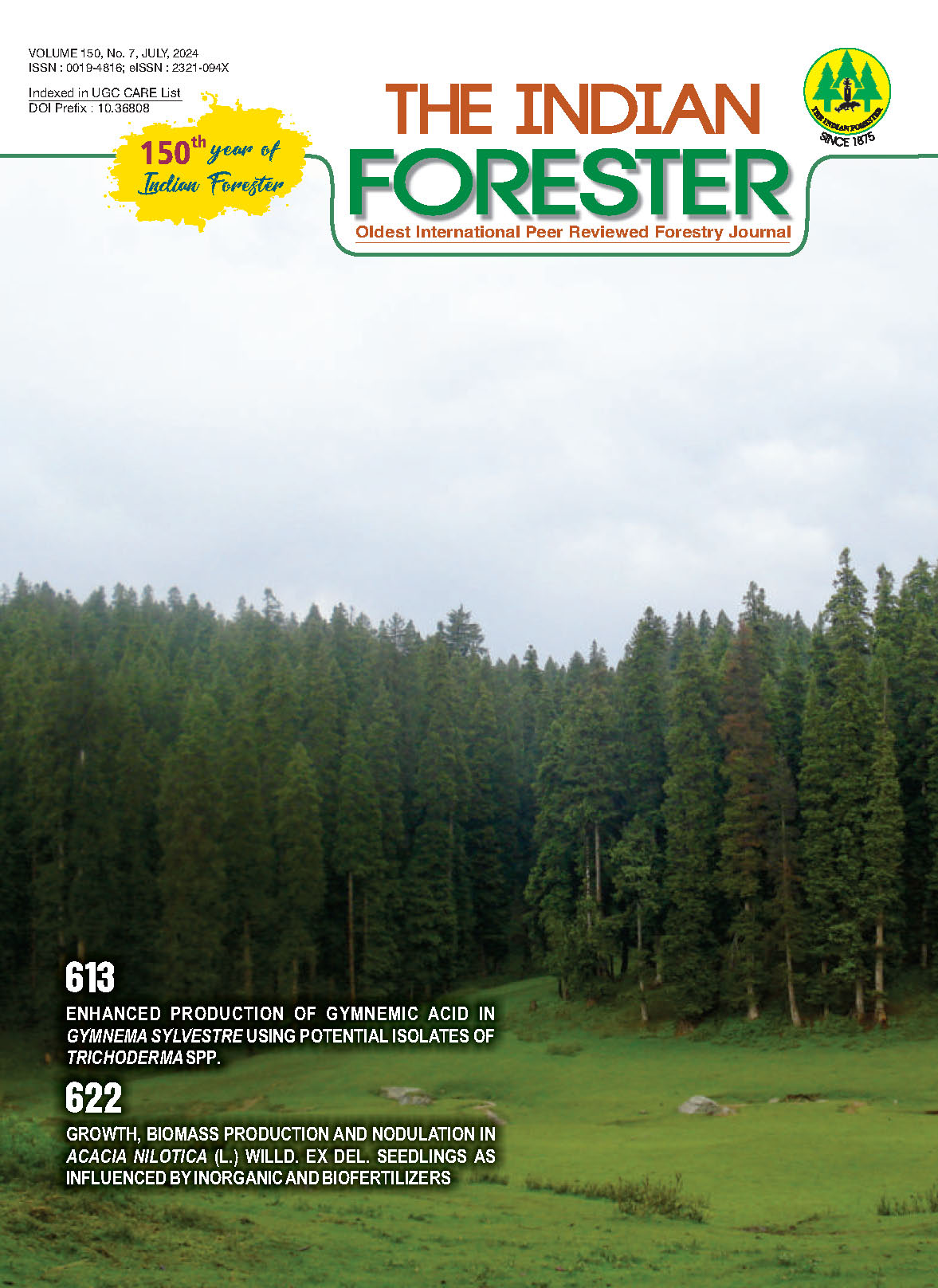Enhanced Production of Gymnemic acid in Gymnema sylvestre using potential Isolates of Trichoderma spp.
DOI:
https://doi.org/10.36808/if/2024/v150i7/170410Keywords:
Gymnema sylvestre, Trichoderma spp., High-Performance Thin- Layer Chromatography (HPTLC), Gymnemic acids.Abstract
Gymnema sylvestre (Retz.) R.Br. ex Sem. is a valuable medicinal herb wellknown for its anti-diabetic, anti-bacterial, and anti-inflammatory properties, primarily found in the Indian subcontinent. In a study conducted across 10 districts of Telangana, samples of G. sylvestre along with soil (rhizosphere and non-rhizosphere) from its habitat were gathered. Among the forty-three Trichoderma spp. isolated from the collected soil and tested, the three most effective isolates were chosen, and applied to G. sylvestre saplings obtained from the aforementioned districts. Using High-Performance Thin-Layer Chromatography (HPTLC), the gymnemic acids content was quantified in both control and treated saplings. The highest concentration of gymnemic acids, reaching 1.14%, was detected in the G. sylvestre sapling obtained from Nirmal district. This sample had been treated with Trichoderma harzianum isolate 25A, originating from non-rhizosphere soil. This discovery presents opportunities for future investigations into sustainable and environmentally friendly methodologies for cultivating G. sylvestre, as well as for the natural production of gymnemic acids through the application of Trichoderma spp. It also underscores the importance of initiating conservation efforts for this species.References
Bhuvaneswari C., Kiranmayee R., Suryakala G. and Archana G. (2012). Abiotic elicitation of gymnemic acid in suspension cultures of Gymnema sylvestre, World Journal of Microbiology and Biotechnology, 28(2): 741-747.
Bhuvaneswari C., Kiranmayee R., Suryakala G. and Archana G. (2013). Improved gymnemic acid production in the suspension cultures of Gymnema sylvestre through biotic elicitation, Plant Biotechnology Report, 7: 519-525.
Hollman-Aragón J.G., Romero-Bastidas M. and ArceAmezquita P.M. Palacios-Espinosa A. (2023). Biostimulant effect of native Trichoderma strain on the germination of four varieties of basil, Mexican Journal of Phytopathology, 42(1): 115.
Javed A., Raad A. Kaskoos, Saima A. and Showkat R. Mir (2020). Quantitative Analysis of Gymnemagenin in Gymnema sylvestre Leaves and in Herbal Formulation by a Validated HPTLC Method, Journal of Biologically Active Products from Nature, 10(3): 211-219.
Patil A.N., Nirmala S.A. and Chavan A.K. (2013). Development and validation of HPTLC Method for Estimation of Gymnemic acid in Microencapsulated Antidiabetic Polyherbal formulations. Acta Chromatographica, 601-612.
Satdive R.K, Abhilash P. and Fulzele D.P. (2003). Antimicrobial activity of Gymnema sylvestre leaf extract, Fitoterapia, 74(7-8): 699–701.
Shimizu K., Abe T., Nakajyo S., Urakawa N., Atsuchi M. and Yamashita C. (1996). Inhibitory effect of glucose utilization by gymnemic acid in guinea pig ileal longitudinal muscle, Journal of Smooth Muscle Research, 32(5): 219−228.
Shimizu K., Lino A., Nakajima J., Tanaka K., Nakajyo S., Urakawa N., Atsuchi M., Wada T. and Yamashita C. (1997). Suppression of glucose absorption by some fractions extracted from Gymnema sylvestre leaves, Journal of Veterinary Medical Science, 59(4): 245−251.
Thiyagarajan M. and Venkatachalam P. (2013). A reproducible and high frequency plant regeneration from mature axillary node explants of Gymnema sylvestre (Gurmur)-An important antidiabetic endangered medicinal plant, Industrial Crops and Products, 1(50): 517-524.
Vasudeva R.N., Venkata S.K., Susmila A.G. , Sukhendu B.G. and Vijaya Tartte (2016). Elicitation of gymnemic acid production in cell suspension cultures of Gymnema sylvestre R.Br. through endophytic fungi, 3 Biotech. Journal of Phytopathology, 6(2): 232
Veerashree V., Anuradha C.M. and Kumar V. (2012). Elicitorenhanced production of gymnemic acid in cell suspension cultures of Gymnema sylvestre R. Br., Journal of Plant Biotechnology, 108(1).
Warksman S.A. (1916). Do fungi live and produce mycelium in the soil? Sci. N.S., 44: 320-322.
Yoshikawa K., Nakagawa M., Yamamoto R., Arihara S. and Matsuura K. (1992). Antisweet natural products. IX. Structures of gymnemic acids XV-XVIII from Gymnema sylvestre R. Br. V., Chemical and Pharmaceutical Bulletin, 40(7): 1779–1782.
Downloads
Downloads
Published
How to Cite
Issue
Section
License
Unless otherwise stated, copyright or similar rights in all materials presented on the site, including graphical images, are owned by Indian Forester.





